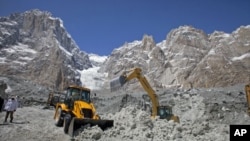In the early morning hours of April 7, a huge avalanche and landslide struck a Pakistani army battalion headquarters located high in the mountains of Kashmir. Rescuers are still searching for survivors beneath rubble that spans one-square-kilometer at the Siachen glacier, in a region long known as a flashpoint between India and Pakistan.
Pakistani soldiers continue to dig, inch-by-inch, in search of 140 colleagues buried under this massive pile of rock.
Rescuers using sniffer dogs and life-detection equipment have braved blizzard-like conditions and threats of fresh avalanches to search through the rubble and snow.
But two weeks after the calamity flattened the Gayari rear base, no victims have been found. Rescuers have not even located evidence of the buried military complex.
Daunting rescue effort continues
Regional army commander Brigadier Saqib Mehmood Malik is supervising the rescue effort.
“The mass of snow and ice and rocks that you see here, this is 200 to 250 feet [61-76 meters] above the ground level. So therefore, this effort is of a very, very large magnitude,” said Malik.
Located at an altitude of 4,000 meters, the disaster zone is just a few kilometers away from the Indian outposts on the disputed Siachen Glacier.
Despite the harsh conditions, Malik refuses to give up the search for the victims.
“So, being a Muslim I believe that I have hope and I will not let it die, I will not let it die,” he said.
Colonel Saeed Iqbal, a former commander of the flattened Pakistani military base, says the incident has saddened him.
“Here we used to play cricket and very proudly we used to say that this is the world highest cricket ground. And you can see those flags, my office was there and living was there, our mess was there,” said Iqbal.
Calls to demilitarize Siachen Glacier
The latest human tragedy on the world’s highest battleground has once again revived calls for demilitarization of the Siachen Glacier, where Pakistan and India together have suffered less than 1,000 casualties, but extreme weather conditions have caused more than 7,000 deaths.
The human tragedy in the glacial region has revived calls for Pakistan and India to end what many critics describe as a “senseless” conflict over the 78-kilometer long Siachen Glacier.
The standoff began in 1984 when Indian troops occupied positions on the northern tip of the “Line of Control” dividing Kashmir. Pakistan responded by establishing posts on Siachen.
Since then, the 28-year-old conflict has cost billions of dollars and killed more than 8,000 soldiers on both sides, giving it the reputation as the world’s highest, coldest and most expensive battlefield.
Resistance to end costly conflict
Army spokesman Major-General Athar Abbas said despite the financial and human losses, Pakistan will not unilaterally pull out forces from the disputed glacier.
“Yes, of course, the loss of life is right in front of everyone on both sides, and our position is that we must go back to the 1984 position and then determine what should be the actual line of deployment, but not before that. This is just an actual ground position line which is because these forces are eyeball-to-eyeball,” said Abbas.
While the digging continues for victims, there is hope that the tragedy could push the two sides toward resolving a conflict that many say is the easiest of all the disputes plaguing India and Pakistan.









